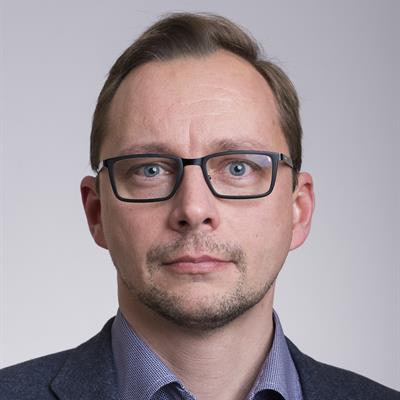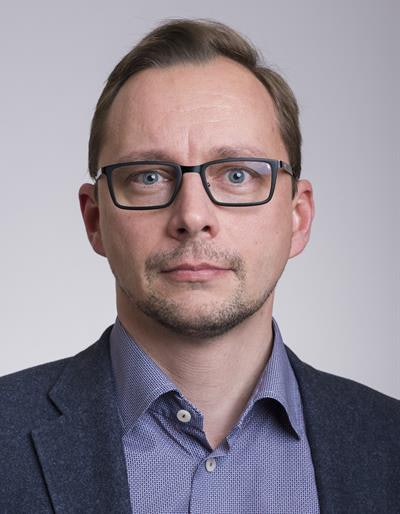
As much as I've enjoyed reading many of Dr. Rinck's columns on AuntMinnieEurope.com, his piece published on 7 August titled "What's gone wrong at the Karolinska?" made me spill my coffee due to its unfortunate inaccuracies and sensationalist claims. Much could have been improved by a little fact-checking.
I will not even try to go through the column's meandering coverage of the new and much-debated New Karolinska Solna (NKS) hospital or value-based care, other than to say the various procurement processes, even if quite unique, have fully conformed to Swedish laws and European Union (EU) directives. Due to the nature and funding of healthcare in Sweden and Stockholm County, the debates tend to become, in my opinion, highly politicized, together with their media coverage.
 Dr. Juhana Hakumäki, PhD. Photo by Anders Norderman.
Dr. Juhana Hakumäki, PhD. Photo by Anders Norderman.On the radiology part, I have an obligation to comment in more detail as the managing director of diagnostic imaging and physiology.
Dr. Rinck writes, for example, that "radiologists proposed (at the NKS) a united radiology department, with cooperation and a location close to pathology," but were denied this, and that "no cooperation with pathology exists."
This simply is not true as the Karolinska has historically had separate radiology departments for both of its hospitals at Solna and Huddinge, as well as neuroradiology and pediatric radiology. There were, on the contrary, quite strong motives within radiology to create stronger, subspecialty-oriented departments, although the results of this change have varied and still are under evaluation.
While it is unfortunately true that pathologists were "forgotten" in some stages of planning of the buildings over the years, pathology is fully integrated into patient flows and the discipline's cooperation with radiology has never disappeared and keeps on improving. To have fine-needle biopsies diagnosed by pathologists online, as in the Karolinska's case, is something many centers can still only dream of. The guiding principle of placing radiologists at NKS near to patients has also shown many advantages for our patients, even if it can be seen as being more resource-demanding for radiology.
Dr. Rinck also claims "the old hospital had a lot of expensive and fairly new equipment," of which "nothing was reused and moved to the new hospital." This is also not true. Much of our newer equipment at the old Solna site is being moved to new premises in Solna as well as our equally important radiology site in Huddinge. This has nothing to do with color of equipment or examination rooms, and even Dr. Rinck himself admits it being just a rumor.
The choice of procuring one imaging vendor for the NKS was made because local politicians, county and hospital officers, as well as radiologists, could all see benefits in what would otherwise have been a massive undertaking by hospital and county employees -- i.e., to equip 320,000 square meters of a top-notch hospital with more than 190 individual pieces of radiological imaging equipment under a timeline of several years. The procurement model was the first of its kind and is by definition "unconventional," but I cannot in my experience say the Karolinska has somehow "gone wrong" with this. The procurement process was even combined with an innovation program, which is already reaping benefits in costs as well as much improved patient care.
Lastly, to claim that "no replacement has been appointed" for the head of radiology only shows how poorly informed the columnist has unfortunately been. There are heads of radiology in place for all sections, as appointed by myself since 2017 and my predecessor, as well as a number of professors who have separate roles from directors and are appointed independently by Karolinska Institute. (See Editor's note below)
While it is true that some specialists have decided to leave the Karolinska over the years, this has been due to a multitude of reasons, with very little that could be directly attributed to the NKS. For specialists in radiology, total turnover since 2015 has been less than 10%, and just around 3% in the last two years, during which time the NKS has been populated and entered into use.
I would like to warmly welcome Dr. Rinck to come for a visit at the Karolinska, where we will gladly show the renowned columnist how life really is and how life goes on despite organizational changes and simultaneously moving around 950 experts in imaging to world-class facilities and equipment at both our sites!
And by the way, according to recent patient satisfaction surveys, more than 95% of Karolinska's patients would highly recommend our imaging and physiology department. We really cannot have gone very wrong.
Editor's note: This error was introduced during the copy editing process. Dr. Rinck's original text read: "When faced with the new structure, the professor of radiology decided to step down. No new professor of radiology has been appointed." This text was wrongly changed to: "When faced with the new structure, the head of radiology decided to step down. No replacement has been appointed." It was in fact the professor of radiology who stepped down, not the head of radiology. We apologize for this error.
Dr. Juhana Hakumäki, PhD, is an adjunct professor and managing director of imaging and physiology at Karolinska University Hospital in Stockholm.



















